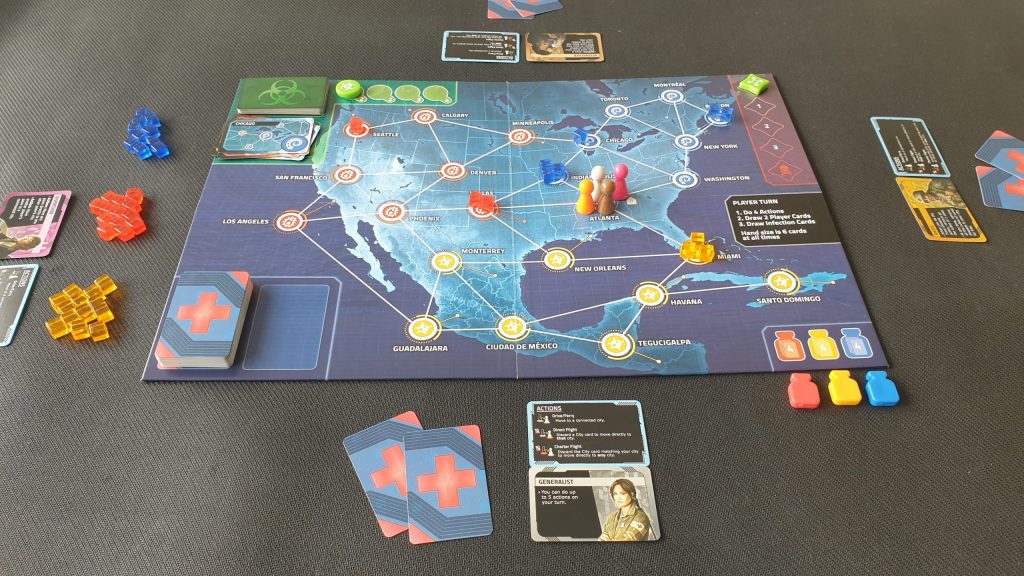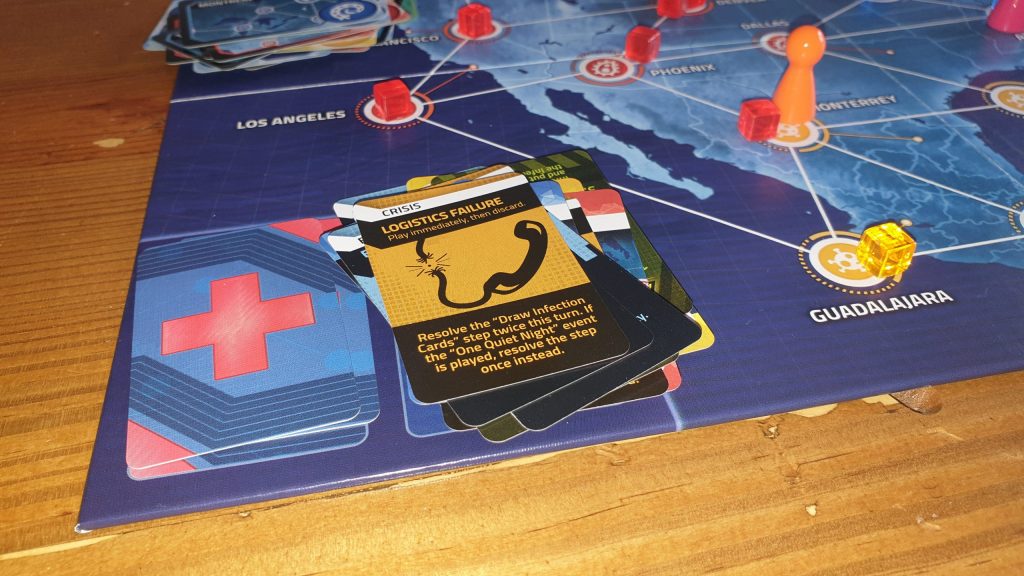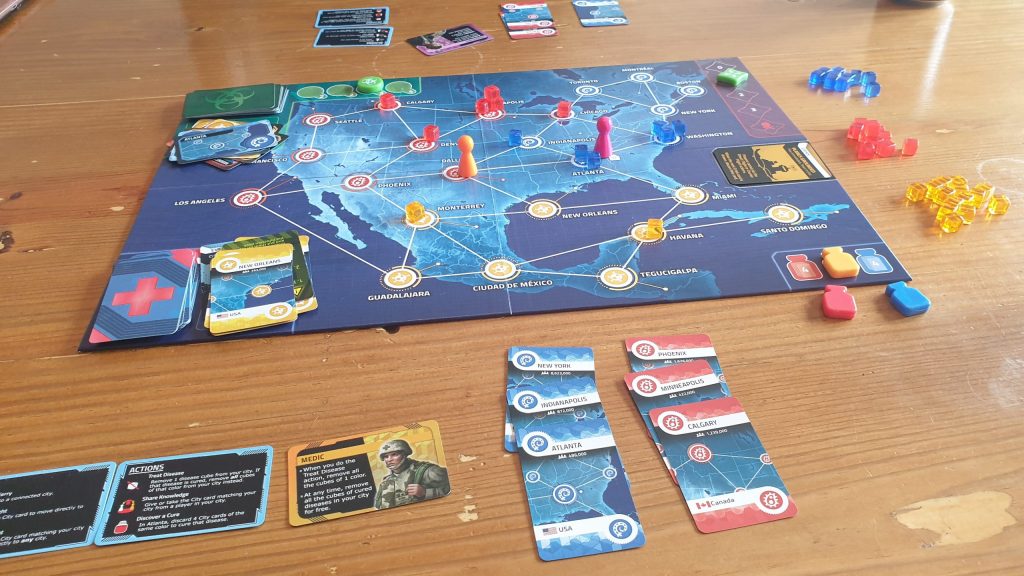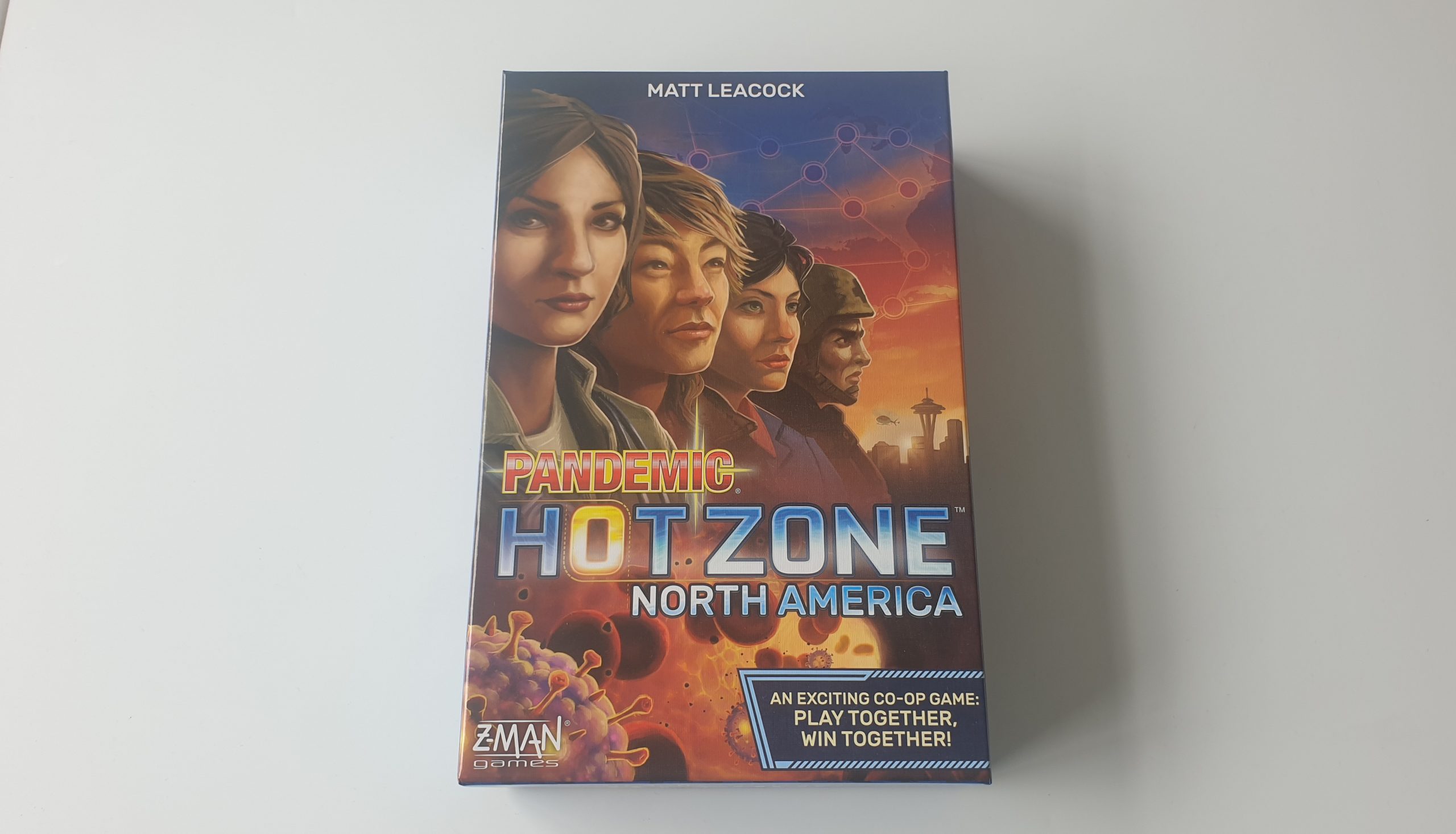Pandemic Hot Zone North America is the brand new cooperative board game, from publisher Z-Man Games. Designed by Matt Leacock, this takes all the concepts of a full Pandemic game and boils them down into a shorter experience – akin to what Ticket to Ride London/New York are to the regular Ticket to Ride. Taking around 25 minutes to play, 2 – 4 players will be still spending actions curing viruses. However, is smaller better? Let’s find out!
For fans of the series, the setup is almost identical to that of regular Pandemic. The new smaller board is placed between players, who each choose one of the included characters. Being set in North America the character pawns still start out in Atlanta – the CDC – though this is the only hospital that will be on the board. While there are three instead of four viruses the coloured cubes are placed at the side of the board and the matching virus cured tokens are put within reach.
The player deck is shuffled, including event cards, which are positive cards the players will be able to use during the game. Dealing out 2/3 cards to each player, depending on the player count, randomises the starting hands. The player deck is then split into 3 with 3 epidemic cards shuffled into the separate thirds, before they are placed on top of each other to form the player draw deck. A new element in Pandemic Hot Zone North America are Crisis cards, though these are only for those whom have played before as they up the difficulty. These are shuffled into the deck thirds at the same time, ready to appear and cause havoc.

The Infection deck is then shuffled, before the initial viruses are spawned. Turning over the top two cards of the deck reveals two cities, which both get 3 virus cubes, of their associated colour, added to them. Two further cards are then flipped, indicating two cities to get 2 virus cubes, before a final two cities are revealed that get one each. Play is then ready to begin with players taking turns clockwise around the table. Each turn sees a player perform 3 phases. First they perform 4 actions, then gain 2 player cards, before a mandatory infection step.
There are a number of actions a player can do. For the most part players will be spending their four actions to move from one city to another, along routes on the board, and to treat locations to remove cubes from the board. Other actions, such as spending player cards to fly to cities or trading cards between players, are possible. These are more situational actions but by no means are they less important. The most important action however is the least performed. Turning in four player cards of matching colour into the Atlanta CDC to discover a cure for the virus matching that colour. To show this has been done the cured virus token of the matching colour is added to the slot on the board, with the team one step closer to victory.
Once a player has performed their actions they draw two player cards. Players must then discard down to a hand limit of 6 cards, using events if possible to get down to the hand limit. If either card is an epidemic, or a crisis card if they are in play, their very negative actions must instantly be performed. Epidemics in Pandemic see the Infection rate tracker increase, see a new city from the bottom of the deck gain 3 virus cubes and all previously flipped infection cards placed back on top of the infection deck. This is a key to driving the pressure of the game as cities that have come out of the deck will soon come back out.

At this point, regardless of if an epidemic occurred or not, it is time for the board to fight back via the Infection step. Turning over a number of infection cards, indicated by the infection rate, each city revealed gains one virus cube – just like during setup. Adding cubes can cause outbreaks to occur. Whenever a 4th cube of a colour should be added to a city an outbreak happens instead. Every connected city gains a cube of the outbreaking virus and the outbreak tracker is advanced. Play then moves onto the next player, who often will try to undo some of this.
The aim is to find the cure for the three viruses, by doing this the team of players will win and save the day. There are however a number of ways to lose. If too many outbreaks occur, if a colour of virus cubes runs out or even if the player deck runs out and more need to be drawn, the team has lost. These represent things like time running out and each can be your downfall.
The crisis cards are what will make the game interesting for veteran Pandemic players, with the experience otherwise a little samey for those that have enjoyed the likes of Pandemic Legacy Season 1 or even Pandemic Iberia. From not being able to fly across the board to a random hot spot, each game will have multiple twists to it. While all bad there are a few that group together “nicely” to really turn up the pressure. Some of the crisis cards stay in play impacting less but for a longer period. Alas, it is perhaps a bit of an oversight not to have a section of the board for them to be placed. Despite being a small board it isn’t like there isn’t room. Thankfully, the turn reminder section works well as a zone to place them as those using the crisis cards shouldn’t need reminding of the turn phases.

Coming with a small board Pandemic Hot Zone North America also includes small cards. These are harder to shuffle, though thankfully they aren’t fiddly in game as they are mostly left on the table. They do, alongside the board, allow the game to have a smaller footprint. Therefore, for portability reasons it makes sense as players will need less table space to play the game. Still, to have incorporated normal sized cards the decks would only have had to have lived off to one side of the board, and this wouldn’t be much of an issue. There is also ample room in the box to have accommodated larger cards.
The tension that made the original thrilling to play is missing from Pandemic Hot Zone North America and it is the lack of time investment that has caused it. The original Pandemic could certainly be over in 15 minutes, but in that time frame the only outcome would be a loss for the players. In 15 minutes players can have won or lost Pandemic Hot Zone North America. There is a tension that slowly builds the more you pour into the game so after 40 minutes the chance of losing adds pressure, and it doesn’t ever get to that point in Hot Zone. A failure is met with more of a shrug and a let’s play again, rather than devastation and dissecting what could have saved the world.
Often games are praised for not outstaying their welcome, and here is the opposite problem. If you don’t have time for a regular game, Pandemic Hot Zone North America does offer the same puzzle: it just doesn’t capture the tension that made me want to keep replaying Pandemic. While not a good replacement for the original it is certainly much easier to get to the table and to travel with. The concept of compact experiences started with the Ticket to Ride franchise. Hopefully, Pandemic is given the opportunity to improve on the first compact game to the second – perhaps furthering the crisis cards feature that makes Pandemic Hot Zone North America a game to try if not buy.
(Editor’s Note: Pandemic Hot Zone North America was provided to us by Asmodee for the review. The game is currently available from local board game stores, some of which are reopening! Find your local store here.)

